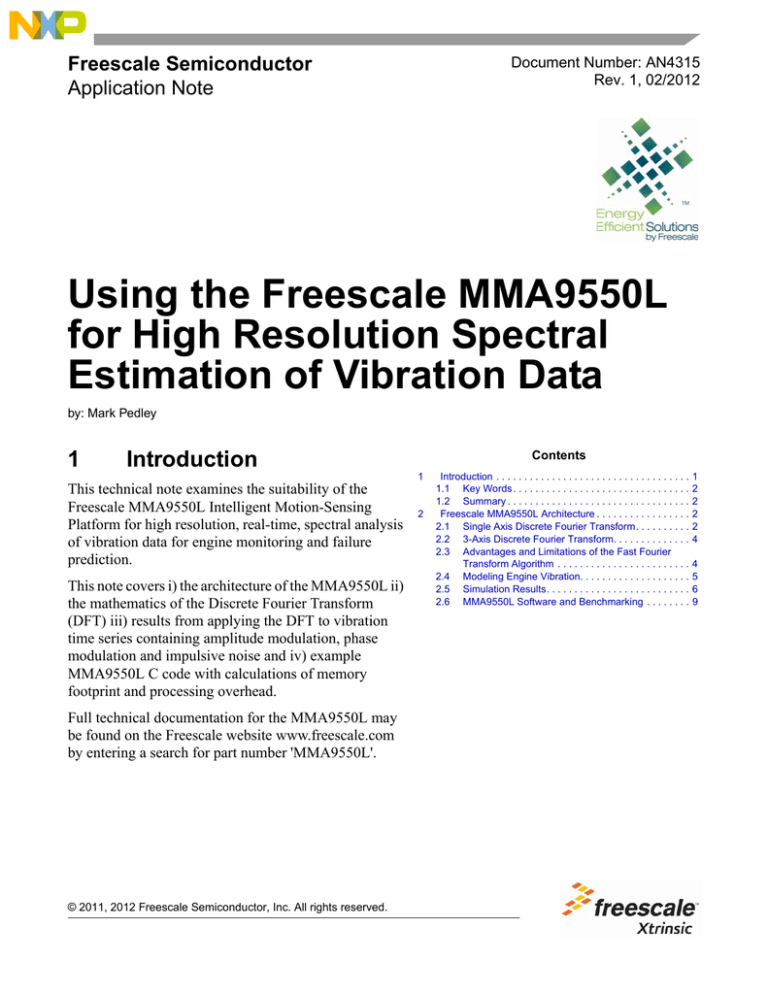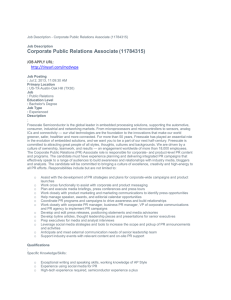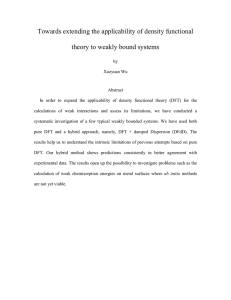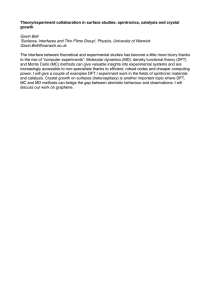
Freescale Semiconductor
Application Note
Document Number: AN4315
Rev. 1, 02/2012
Using the Freescale MMA9550L
for High Resolution Spectral
Estimation of Vibration Data
by: Mark Pedley
1
Introduction
Contents
1
This technical note examines the suitability of the
Freescale MMA9550L Intelligent Motion-Sensing
Platform for high resolution, real-time, spectral analysis
of vibration data for engine monitoring and failure
prediction.
This note covers i) the architecture of the MMA9550L ii)
the mathematics of the Discrete Fourier Transform
(DFT) iii) results from applying the DFT to vibration
time series containing amplitude modulation, phase
modulation and impulsive noise and iv) example
MMA9550L C code with calculations of memory
footprint and processing overhead.
Full technical documentation for the MMA9550L may
be found on the Freescale website www.freescale.com
by entering a search for part number 'MMA9550L'.
© 2011, 2012 Freescale Semiconductor, Inc. All rights reserved.
2
Introduction . . . . . . . . . . . . . . . . . . . . . . . . . . . . . . . . . . .
1.1 Key Words . . . . . . . . . . . . . . . . . . . . . . . . . . . . . . . .
1.2 Summary . . . . . . . . . . . . . . . . . . . . . . . . . . . . . . . . .
Freescale MMA9550L Architecture . . . . . . . . . . . . . . . . .
2.1 Single Axis Discrete Fourier Transform. . . . . . . . . .
2.2 3-Axis Discrete Fourier Transform. . . . . . . . . . . . . .
2.3 Advantages and Limitations of the Fast Fourier
Transform Algorithm . . . . . . . . . . . . . . . . . . . . . . . .
2.4 Modeling Engine Vibration. . . . . . . . . . . . . . . . . . . .
2.5 Simulation Results. . . . . . . . . . . . . . . . . . . . . . . . . .
2.6 MMA9550L Software and Benchmarking . . . . . . . .
1
2
2
2
2
4
4
5
6
9
Freescale MMA9550L Architecture
1.1
Key Words
MMA9550L, DFT, FFT, Vibration, Spectral Analysis, Amplitude Modulation, Phase Modulation,
Impulsive Noise.
1.2
Summary
1. Abnormal operating conditions, indicating developing wear or possible imminent failure, can
manifest as characteristic signals in the vibration spectrum of the machinery.
2. The vibration spectrum can be computed by direct evaluation of the DFT or by using the FFT
algorithm. It is shown that the FFT algorithm adds a significant overhead in memory use and
produces only a minor reduction in computation when only a limited number of vibration
frequencies are of interest.
3. Calculation of the DFT in no more than 16 frequency bins is shown to be effective at determining
the characteristic features of amplitude modulation, phase modulation and impulsive noise present
in vibration data measured by the MMA9550L's accelerometer.
4. Reference C code shows that the MMA9550L is capable of computing 16 DFT bins from all three
accelerometer channels, in real time at kHz rates, and is ideally suited for this application.
2
Freescale MMA9550L Architecture
Freescale's MMA9550L integrates a 3-axis 8-bit to 14-bit MEMS accelerometer, an 8 MHz 32-bit Coldfire
processor core, 16 KB flash memory and 2 KB SRAM into a single 3 mm by 3 mm 16 pin package drawing
less than 5 mW power. The MMA9550L is targeted towards applications requiring processing of
accelerometer data at low cost and low power. The MMA9550L communicates with an external processor
over a 2 Mbps slave I2C bus or via an interrupt pin.
The MMA9550L accelerometer is configurable to operate in ±2g, ±4g and ±8g modes with 8-bit to 14-bits
resolution at sampling rates up to 3.9 kHz. A 400 kbps master I2C interface allows additional
accelerometers or other sensors to be interfaced to the MMA9550L.
2.1
Single Axis Discrete Fourier Transform
The Discrete Fourier Transform (DFT) X(ω) of the N point sampled accelerometer x-axis data series I[] at
normalized angular frequency ω (or frequency f in Hz) is:
N–1
X(ω) =
∑ x [ n ]e
– iωn
Eqn. 1
n=0
N–1
X( f) =
∑ x [ n ]e
2πifn
– ⎛ --------------⎞
⎝ fs ⎠
Eqn. 2
n=0
Using the Freescale MMA9550L for High Resolution Spectral Estimation of Vibration Data, Rev. 1
2
Freescale Semiconductor, Inc.
Freescale MMA9550L Architecture
ω and f are related through the sampling frequency fs by:
2πf
ω = -------fs
Eqn. 3
ω and f are limited between the negative and positive Nyquist frequencies:
–π < ω ≤ π
Eqn. 4
f
f
– ⎛ ---s⎞ < f ≤ ⎛ ---s⎞
⎝ 2⎠
⎝ 2⎠
Eqn. 5
The frequency resolution achievable from a time series of N data points improves proportionally to N and
it is common practice to evaluate the DFT X[k] at N equally spaced normalized angular frequency bins
ω[k]:
2πk
ω [ k ] = --------N
N–1
X[k] =
∑ x [ n ]e
Eqn. 6
2πikn
– ⎛⎝ ---------------⎞⎠
N
Eqn. 7
n=0
N
N
– ---- < k ≤ ---2
2
Eqn. 8
N
N
N- since it is easily verified that X –
------- = X ---- .
The range of k in Equation 8 does not include k = –-----2
2
2
The value of the DFT for vibration analysis is that frequencies present in the time series x[n] are
transformed into peaks at the appropriate DFT frequency bin. Specifically, if x[n] is a complex sinusoid
2πl- then:
with amplitude a[l] and normalized angular frequency ω [ l ] = ------N
x [ n ] = a [ l ]e
N–1
X[k] = [k] =
∑
x [ n ]e
2πikn
– ⎛ ---------------⎞
⎝ N ⎠
⎛ 2πiln
-------------⎞
⎝ N ⎠
Eqn. 9
N–1
= a[l]
n=0
∑
e
2πi ( l – k )n-⎞
⎛ --------------------------⎝
⎠
N
Eqn. 10
n=0
For k = l, Equation 10 simplifies to:
X [ l ] = Na [ l ]
Eqn. 11
Using the Freescale MMA9550L for High Resolution Spectral Estimation of Vibration Data, Rev. 1
Freescale Semiconductor, Inc.
3
Freescale MMA9550L Architecture
For k ≠ l , equation 10 is the sum of a geometric progression which evaluates to zero:
2πi ( l – k )
{1 – e
}
X [ k ] = --------------------------------------- = 0
2πi ( l – k )⎞
⎛ ----------------------⎝
⎠⎫
⎧
N
⎨1 – e
⎬
⎩
⎭
Eqn. 12
A sinusoid at normalized angular frequency ω [l] therefore manifests as a peak of value Nα[l] in bin l of
the DFT with all other bins zero. Since the DFT is a linear operator, an input time series comprising the
sum of sinusoids of multiple frequencies has a DFT with peaks at those frequencies with magnitude
proportional to those of the component sinusoids. The magnitude squared of the DFT is commonly
referred to as the "power spectrum" of the input time series.
2.2
3-Axis Discrete Fourier Transform
Equation 1 can be readily extended to compute the DFTs Y(ω) and Z(ω) of the two other accelerometer
data series y[] and z[].
The DFT amplitude A(ω) of the combined spectrum from all three accelerometer channels can be
computed from the DFTs of the individual channels. Vibration frequencies present in any of the three
accelerometer channels appear without distortion in the three-axis amplitude A(ω):
A(ω) =
2
2
{X(ω) } + {Y( ω) } + {Z(ω )}
2
Eqn. 13
The DFT should not be computed from the modulus a[n] of the three axes of acceleration signals. The
acceleration time series a[n] is non-negative resulting in harmonic distortion and the appearance of DFT
peaks at integer multiples of the original frequencies.
α[n] =
2.3
2
2
x[ n] + y[n] + z[ n]
2
Eqn. 14
Advantages and Limitations of the Fast Fourier Transform
Algorithm
The computational complexity of the DFT in Equation 7 is quadratic in N since it involves the summation
over N data points to compute the DFT in N frequency bins. The Fast Fourier Transform (FFT) algorithm
is an extremely efficient algorithm to compute the DFT over the N equally spaced bins of Equation 7 with
computational complexity proportional to Nlog2N. Even for small data series of N = 1024 = 210 points,
10
2
- ≈ 100 . For million point FFTs N = 1048576 = 220 the computational saving from
the saving is --------------------10
log 2( 2 )
20
2
- ≈ 50000 . The FFT algorithm is therefore unarguably superior in
using the FFT algorithm is --------------------20
log 2( 2 )
computational efficiency compared to direct calculation of the DFT provided that the DFT is required at
all N frequency bins.
Using the Freescale MMA9550L for High Resolution Spectral Estimation of Vibration Data, Rev. 1
4
Freescale Semiconductor, Inc.
Freescale MMA9550L Architecture
If the DFT is required at a lower number of frequency bins M, where M < N, then the FFT algorithm may
not be the most efficient. Specifically, direct calculation of the DFT will be more efficient for M < log2N
which for N = 1024 data points occurs at M =10 frequency bins.
The FFT algorithm is efficient in using working memory since the algorithm over-writes the N input data
points with the N output data points. However, an N point FFT still requires storage of N complex values
each of which, in fixed point systems, typically consists of two 32-bit integers or 8 bytes per bin and 8N
bytes storage in total.
In contrast, the DFT calculation of M frequency bins requires 8M bytes for the complex DFT bin plus (as
will be seen later) 8M bytes for phasor storage totaling 16M bytes. This 16M byte storage requirement for
direct DFT calculation is independent of the number of points N used in the calculation which is a major
advantage over the FFT for long data sequences.
Assuming that 256 bytes per accelerometer channel of the 2 KB working RAM in the MMA9550L is
available for spectral estimation, then the FFT algorithm is limited to just 256/8 = 32 input data points and
32 frequency bins. At a sampling rate of 2 kHz, the spectral resolution is just 2000/32 = 62 Hz.
In contrast, the use of the DFT on a sample by sample basis using the same 256 bytes of storage allows the
calculation of the spectrum at 16M = 256 or M = 16 unique frequency points using an arbitrary number of
accelerometer readings which in turn leads to arbitrary high spectral resolution. The 16 available
frequency bins may be positioned uniformly within ±1 Hz of a frequency component giving a DFT
resolution of just 0.125 Hz. 8s x 2 kHz = 16000 accelerometer measurements will be required to achieve
that frequency resolution but this does not increase the storage requirement.
Using the FFT algorithm with the same 2 kHz sampling frequency, this same resolution requires the
storage of all 8s x 2 kHz = 16000 accelerometer measurements. This is not remotely feasible for the
MMA9550L nor other low cost embedded processors.
The M = 16 available frequency bins for direct sample by sample DFT calculation will normally be i)
located in the immediate vicinity of the fundamental to provide high resolution analysis and also ii) at
multiples of the machinery fundamental for broad band analysis. These situations are examined in more
detailed in the remainder of this technical note.
2.4
Modeling Engine Vibration
This section contains the results of modeling various sources of vibration disturbance on rotating
machinery and demonstrates the ability to compute their characteristics using only a small number of DFT
bins.
A well-balanced and stable machine operating at frequency fo will create a small level of vibration at
frequency fo only. Increasing engine wear and loss of stability will, however:
a) increase the magnitude of the vibration at frequency fo
b) decrease the stability of the engine rotation
c) introduce once per rotation cycle perturbations (one example being 'knocking' in internal
combustion engines)
Using the Freescale MMA9550L for High Resolution Spectral Estimation of Vibration Data, Rev. 1
Freescale Semiconductor, Inc.
5
Freescale MMA9550L Architecture
A simple mathematical model represents the vibration in one accelerometer axis x[n] by:
2πf M n⎞ ⎫
2πf 0 n
⎧
- cos ⎛ ------------x [ n ] = A ⎨ 1 + ε cos ⎛ -------------- + ψ [ n ]⎞ + B
⎝ fs ⎠ ⎬
⎝ fs
⎠
⎩
⎭
∞
f0 n
∑ δ j – ------f j = –∞
Eqn. 15
s
The machinery vibration fundamental has amplitude A at frequency fo with amplitude modulation with
depth δ at frequency fM.
ψ[n] is phase modulation noise modelled as a sinusoidally varying phase error of defined frequency and
amplitude.
The final term is a Dirac comb function which comprises an infinite number of delta functions δ[] centered
f
f0
at intervals of ---s samples and which represents repetitive impulsive noise with amplitude Β.
Simple Fourier analysis predicts that:
a) amplitude modulation will split the DFT peak at the fundamental frequency f0
b) phase modulation will broaden the DFT peak at the fundamental frequency f0
c) impulse noise occurring once per cycle will create peaks in the DFT at integer multiples of the
fundamental frequency f0.
The next section shows that these predicted signatures can be determined using just a limited number of
DFT bins.
2.5
Simulation Results
The simulations in this section used a sampling frequency fs of 2 kHz and an engine fundamental frequency
f0 equal to 244 Hz. The fundamental vibration amplitude A was 64 bits. 5s or 10,000 data points were
analyzed into the fundamental plus 10 narrow band frequency bins and 3 broad band frequency bins.
Figure 1 shows a narrow band DFT computed in 11 bins between 243 Hz and 245 Hz in the absence of
any additional distortions. The DFT resolution of 0.2 Hz is matched to the 5s duration of the data analyzed.
Only the vibration of the engine fundamental appears in the DFT.
Narrow Band: No Distortion
1000000
100000
10000
D
F
T
1000
100
10
1
243.0 243.2 243.4 243.6 243.8 244.0 244.2 244.4 244.6 244.8 245.0
Frequency (Hz)
Figure 1. Narrow Band DFT with no distortion
Using the Freescale MMA9550L for High Resolution Spectral Estimation of Vibration Data, Rev. 1
6
Freescale Semiconductor, Inc.
Freescale MMA9550L Architecture
Figure 2 shows the narrow band DFT but in the presence of amplitude modulation of the fundamental
frequency with 0.6 Hz modulation frequency and modulation amplitude equal to 0.1%. The amplitude
modulation is clearly resolved by peaks separated from the fundamental by 0.6 Hz.
Narrow Band: Amplitude Modulation
1000000
100000
10000
D
F
T
1000
100
10
1
243.0 243.2 243.4 243.6 243.8 244.0 244.2 244.4 244.6 244.8 245.0
Frequency (Hz)
Figure 2. Narrow Band DFT with amplitude modulation
Figure 3 shows the narrow band DFT in the presence of a sinusoidally varying phase error with modulation
frequency of 0.1 Hz and amplitude of 0.01 radians. The broadening of the fundamental peak is clearly
visible indicating loss of frequency stability.
Narrow Band: Phase Modulation
1000000
100000
10000
D
F
T
1000
100
10
1
243.0 243.2 243.4 243.6 243.8 244.0 244.2 244.4 244.6 244.8 245.0
Frequency (Hz)
Figure 3. Narrow Band DFT with Phase Modulation
Using the Freescale MMA9550L for High Resolution Spectral Estimation of Vibration Data, Rev. 1
Freescale Semiconductor, Inc.
7
Freescale MMA9550L Architecture
Figure 4 shows the DFT computed at the engine fundamental frequency and at three harmonics of the
fundamental. In the absence of distortion, there is no DFT energy at the higher harmonics.
Broad Band: No Distortion
1000000
100000
10000
D
F
T
1000
100
10
1
244.0
488.0
732.0
976.0
Frequency (Hz)
Figure 4. Broad Band DFT with no distortion
Figure 5 shows the same DFT but in the presence of repetitive impulse noise with amplitude 1 bit
occurring once per cycle of the fundamental. The impulse noise is readily detectable at the harmonics of
the fundamental frequency.
Broad Band: Impulse Noise
1000000
100000
10000
D
F
T
1000
100
10
1
244.0
488.0
732.0
976.0
Frequency (Hz)
Figure 5. Broad Band DFT with repetitive impulse noise
The conclusion of this section is that calculation of the DFT at a limited number of bins can detect engine
vibration disturbances of the different types discussed. The frequencies of the DFT bins to be computed
are readily determined from the engine fundamental frequency.
Using the Freescale MMA9550L for High Resolution Spectral Estimation of Vibration Data, Rev. 1
8
Freescale Semiconductor, Inc.
Freescale MMA9550L Architecture
2.6
MMA9550L Software and Benchmarking
It is highly inefficient to compute the complex phasor in Equation 2 though calls to trigonometric
functions. An alternative and efficient iterative approach updates the phasor φ[f,n] for frequency f at data
sample n by rotating the phasor φ[f,n - 1] from the previous sample by the constant rotation angle phasor
φ[f,1]:
φ [ f, 0 ] = 1
φ [ f, 1 ] = e
φ [ f, n ] = e
2πif
– ⎛ -----------⎞
⎝ fs ⎠
= e
Eqn. 16
( – 2πif )
------------------fs
2πif ( n – 1 )
– 2 πif
– ⎛ --------------------------⎞ ⎛ --------------⎞
⎝
⎠ ⎝ fs ⎠
fs
e
Eqn. 17
= φ [ f, n – 1 ]φ [ f, 1 ]
Eqn. 18
( – 2πif )
------------------fs
The rotation phasor φ [ f, 1 ] = e
is a constant which defines the DFT frequency of interest and only
needs calculation once either i) by the MMA9550L from the required frequency f or, more likely, ii)
computed and downloaded to the MMA9550L by an external processor at initialization of the
MMA9550L.
Equation 2 can now be implemented in a recursive algorithm as:
X ( f, 0 ) = x [ 0 ]
Eqn. 19
X ( f, n ) = X ( f, n + 1 ) + x [ n ]φ [ f, n ]
Eqn. 20
The key code kernel which executes once per sample for the computation of NBINS DFT bins from a
single accelerometer channel the vibration data sample x[n] is listed below.
The compile time constant SCALING is application dependent and should be set to prevent overflow for the
typical vibration amplitude measured and the length of the accelerometer time series used in the
summation.
The real and imaginary components of the rotation phasor are stored in Q15 integer format where -32768
represents -1.000 and +32767 represents 0.9999.
INT16
INT16
INT16
INT16
INT32
INT32
INT16
INT16
INT16
RePhasor1[NBINS];/* array of real parts of rotation phasor Phi(f,1) */
ImPhasor1[NBINS];/* array of imaginary parts of rotation phasor Phi(f,1) */
RePhasorn[NBINS];/* array of real parts of rotation phasor Phi(f,n) */
ImPhasorn[NBINS];/* array of imaginary part of rotation phasor Phi(f,n) */
ReDFT[NBINS];/* array of real parts of DFT bins */
ImDFT[NBINS];/* array of imaginary parts of DFT bins */
temp;/* temporary register */
xn;/* current accelerometer sample from one channel */
i; /* loop counter */
/* loop over all frequency bins where the DFT is to be computed */
for (i = 0; i < NBINS; i++)
{
Using the Freescale MMA9550L for High Resolution Spectral Estimation of Vibration Data, Rev. 1
Freescale Semiconductor, Inc.
9
Freescale MMA9550L Architecture
/* update the DFT bin for sample xn using the current frequency phasor */
ReDFT[i] += (xn * RePhasorn[i]) >> SCALING;
ImDFT[i] += (xn * ImPhasorn[i]) >> SCALING;
/* update the frequency phasor for the next iteration */
temp = RePhasorn[i];
RePhasorn[i] = (INT16) ((RePhasorn[i] * RePhasor1[i] - ImPhasorn[i] * ImPhasor1[i]) >> 15);
ImPhasorn[i] = (INT16) ((temp * ImPhasor1[i] + ImPhasorn[i] * RePhasor1[i]) >> 15);
}
Four INT16s and two INT32s (totaling 16 bytes) are required for each DFT frequency bin resulting in 16M
bytes of RAM storage per accelerometer channel for calculation of M DFT frequency bins. This is an
extremely small RAM footprint permitting M = 16 DFT frequencies to be computed for all three
accelerometer channels using just 3 x 16 x 16 = 768 bytes of the MMA9550L's 2KB internal RAM. The
RAM storage requirement is completely independent of the number of accelerometer data points analyzed.
The code kernel above requires just 10 arithmetic operations per accelerometer sample per DFT bin per
accelerometer channel. At sampling frequency fs and with NBINS DFT frequencies computed, the
arithmetic processing rate for all three accelerometer channels is 10 x 3 x NBINS x fs or 480 fs operations
per second for NBINS = 16. For fs = 2 kHz this totals 1M arithmetic operations per second, well within the
processing capability of the 8 MHz MMA9550L.
Using the Freescale MMA9550L for High Resolution Spectral Estimation of Vibration Data, Rev. 1
10
Freescale Semiconductor, Inc.
How to Reach Us:
Home Page:
www.freescale.com
Web Support:
http://www.freescale.com/support
USA/Europe or Locations Not Listed:
Freescale Semiconductor, Inc.
Technical Information Center, EL516
2100 East Elliot Road
Tempe, Arizona 85284
1-800-521-6274 or +1-480-768-2130
www.freescale.com/support
Europe, Middle East, and Africa:
Freescale Halbleiter Deutschland GmbH
Technical Information Center
Schatzbogen 7
81829 Muenchen, Germany
+44 1296 380 456 (English)
+46 8 52200080 (English)
+49 89 92103 559 (German)
+33 1 69 35 48 48 (French)
www.freescale.com/support
Japan:
Freescale Semiconductor Japan Ltd.
Headquarters
ARCO Tower 15F
1-8-1, Shimo-Meguro, Meguro-ku,
Tokyo 153-0064
Japan
0120 191014 or +81 3 5437 9125
support.japan@freescale.com
Asia/Pacific:
Freescale Semiconductor China Ltd.
Exchange Building 23F
No. 118 Jianguo Road
Chaoyang District
Beijing 100022
China
+86 10 5879 8000
support.asia@freescale.com
For Literature Requests Only:
Freescale Semiconductor Literature Distribution Center
1-800-441-2447 or +1-303-675-2140
Fax: +1-303-675-2150
LDCForFreescaleSemiconductor@hibbertgroup.com
Document Number: AN4315
Rev. 1
02/2012
Information in this document is provided solely to enable system and software
implementers to use Freescale Semiconductor products. There are no express or
implied copyright licenses granted hereunder to design or fabricate any integrated
circuits or integrated circuits based on the information in this document.
Freescale Semiconductor reserves the right to make changes without further notice to
any products herein. Freescale Semiconductor makes no warranty, representation or
guarantee regarding the suitability of its products for any particular purpose, nor does
Freescale Semiconductor assume any liability arising out of the application or use of any
product or circuit, and specifically disclaims any and all liability, including without
limitation consequential or incidental damages. “Typical” parameters that may be
provided in Freescale Semiconductor data sheets and/or specifications can and do vary
in different applications and actual performance may vary over time. All operating
parameters, including “Typicals”, must be validated for each customer application by
customer’s technical experts. Freescale Semiconductor does not convey any license
under its patent rights nor the rights of others. Freescale Semiconductor products are
not designed, intended, or authorized for use as components in systems intended for
surgical implant into the body, or other applications intended to support or sustain life,
or for any other application in which the failure of the Freescale Semiconductor product
could create a situation where personal injury or death may occur. Should Buyer
purchase or use Freescale Semiconductor products for any such unintended or
unauthorized application, Buyer shall indemnify and hold Freescale Semiconductor and
its officers, employees, subsidiaries, affiliates, and distributors harmless against all
claims, costs, damages, and expenses, and reasonable attorney fees arising out of,
directly or indirectly, any claim of personal injury or death associated with such
unintended or unauthorized use, even if such claim alleges that Freescale
Semiconductor was negligent regarding the design or manufacture of the part.
Freescale and the Freescale logo are trademarks of Freescale Semiconductor, Inc.,
Reg. U.S. Pat. & Tm. Off. The Energy Efficiency Solutions Logo and Xtrinsic are
trademarks of Freescale Semiconductor, Inc.
All other product or service names are the property of their respective owners.
© 2012 Freescale Semiconductor, Inc. All rights reserved.






